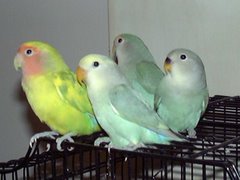How to Perform Mutations in Masked Lovebirds?
Do you know the first mutation in masked lovebird was first captured in 1927? Nowadays they're bred fairly successfully not only in Japan, Taiwan, Hong Kong and US, but also in Europe.
Are you going to mutate masked lovebirds? Then, it is not good idea to pair blue with blue continually. Occasionally cross a blue with a normal-colored specimen to improve the quality of the blues bred. Do follow the followinng breeding regimen to get perfectly mutated masked ones: -
Blue x Blue = all blue birds
Blue x Normal = all normal, some of which are split for blue
Blue x Split blue = approx. half blue and half split blue
Split blue x Split blue = approx. half split, a quarter blue and quarter normal
You can identify blues when they are still in the nest because they have white down, whereas normal have reddish down. An adult blue is blue where the normally colored bird is green; gray-white instead of yellow; the beak is bright red.
Further mutations include yellows and whites but the names are misleading because the birds are not pure yellow or pure white.
There has also been a gray-winged mutation, produced by yellows and whites. Its head and primaries are virtually white. I also have known of cinnamon-colored masked lovebirds in Japan.
Are you going to mutate masked lovebirds? Then, it is not good idea to pair blue with blue continually. Occasionally cross a blue with a normal-colored specimen to improve the quality of the blues bred. Do follow the followinng breeding regimen to get perfectly mutated masked ones: -
Blue x Blue = all blue birds
Blue x Normal = all normal, some of which are split for blue
Blue x Split blue = approx. half blue and half split blue
Split blue x Split blue = approx. half split, a quarter blue and quarter normal
You can identify blues when they are still in the nest because they have white down, whereas normal have reddish down. An adult blue is blue where the normally colored bird is green; gray-white instead of yellow; the beak is bright red.
Further mutations include yellows and whites but the names are misleading because the birds are not pure yellow or pure white.
There has also been a gray-winged mutation, produced by yellows and whites. Its head and primaries are virtually white. I also have known of cinnamon-colored masked lovebirds in Japan.







 Free Ads For Bloggers
Free Ads For Bloggers


No comments:
Post a Comment